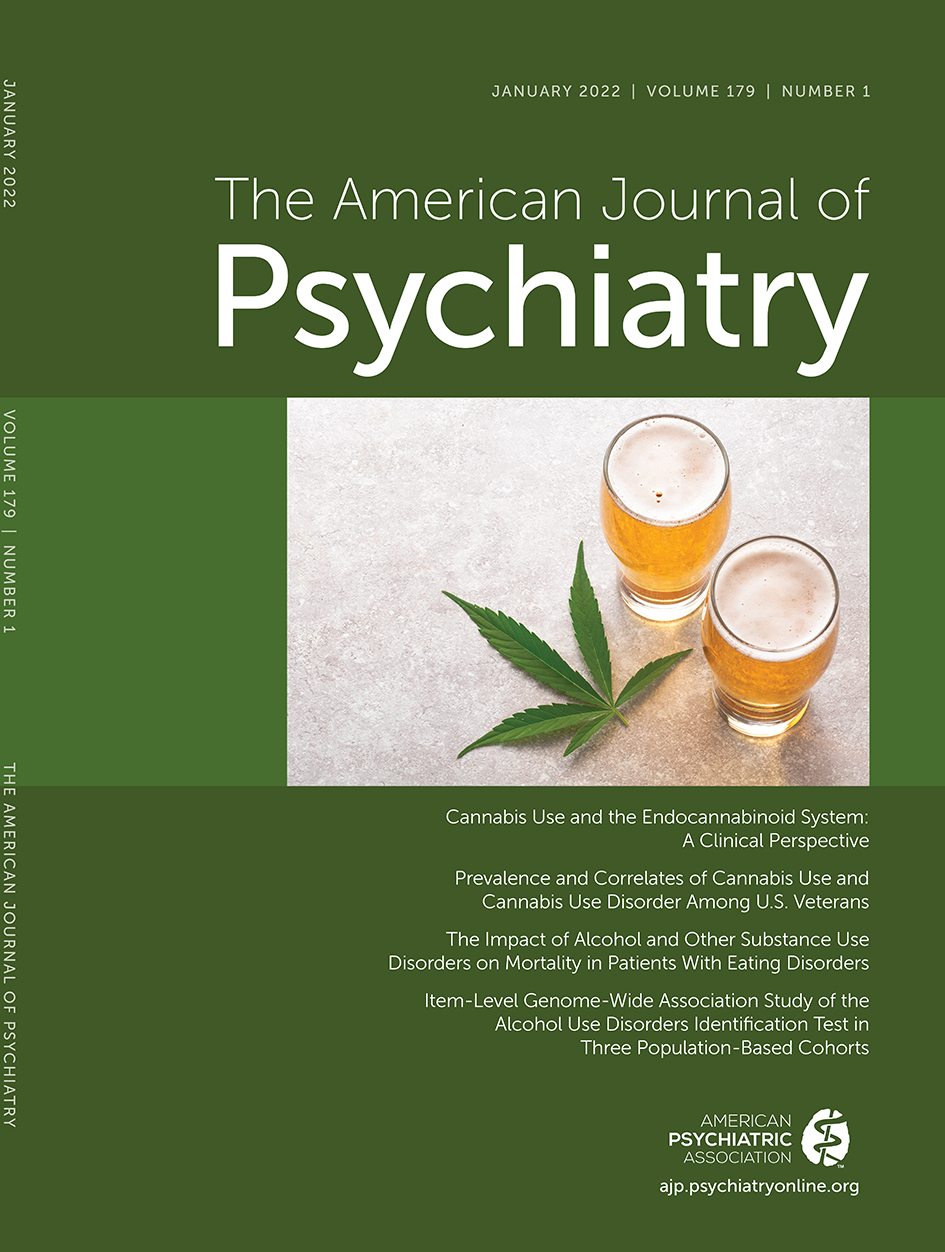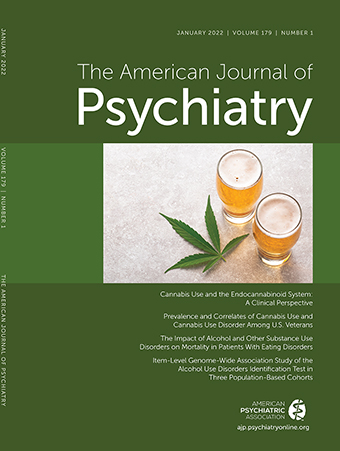Many conditions approved for medical cannabis use are common among veterans (e.g., posttraumatic stress disorder [PTSD]), and veteran groups have advocated for legalization (
1,
7–
9). However, little is known about the prevalence and correlates of cannabis use among U.S. veterans. Studies of Veterans Health Administration (VHA) patients showed that 11%–14% used cannabis (
10,
11). However, many U.S. veterans do not utilize VHA care (
12). Only one study examined cannabis use in a nationally representative sample that included veterans without regard to VHA enrollment (
13), showing that 9% of veterans reported past-year cannabis use. Other studies examining trends, recreational versus medical cannabis use, or cannabis use disorder among veterans are older (
4) or are limited to particular subsamples (
4,
13–
15).
Given growing legalization and acceptability of cannabis use, nationally representative data are needed to understand cannabis use among veterans, including frequent use patterns (e.g., daily use) and cannabis use disorder, and to identify high-risk subgroups (
3,
13,
16). In civilian samples, frequent cannabis use and cannabis use disorder are associated with other substance and psychiatric disorders—for example, PTSD and anxiety and mood disorders (
17–
19)—and may worsen their outcomes (
20–
22). Such disorders are overrepresented among veterans (
23,
24). Additionally, since civilian studies show higher rates of adult cannabis use in states with legalized cannabis than in other states (
16,
25–
28), understanding the risk for cannabis use among veterans in states with and without medical marijuana laws is critical to understanding public health effects of legalization among veterans. Only one such study exists, a VHA medical record study suggesting that in 2009, ICD-9-CM cannabis use disorder was more common among veterans in VHA care in states with medical marijuana laws (
4). More recent, representative information is needed.
DISCUSSION
Among veteran respondents in the NESARC-III survey, over 7% had used cannabis during the previous 12 months, and 1.8% met criteria for cannabis use disorder. Corresponding lifetime prevalence estimates were 32.5% and 5.7%, respectively. Approximately 1 in 4 (24.4%) who used nonmedical cannabis in the past 12 months met criteria for 12-month cannabis use disorder, and more than 1 in 6 (17.4%) who reported lifetime nonmedical use met criteria for lifetime cannabis use disorder. Sociodemographic correlates of nonmedical use and cannabis use disorder included being younger, being male, being unmarried, and having a lower income. Cannabis use and cannabis use disorder were associated with most psychiatric and substance use disorders examined. Finally, veterans in states with legalized medical cannabis were more likely than those in other states to use cannabis nonmedically and to have cannabis use disorder.
Two previous studies addressing cannabis use or cannabis use disorder among veterans in VHA care with mental health needs (
10,
11) reported higher prevalence of cannabis use than we found in the present study, perhaps owing to the association of cannabis use with psychiatric disorders (
10,
11). A study utilizing 2009 VHA-wide electronic medical record data (
4) found a prevalence of past-year cannabis use disorder among VHA-enrolled veterans ∼70% lower than we found using the 2012–2013 NESARC-III data. This may reflect national increases in cannabis use disorder (
3), or it may be because VHA providers do not routinely assess cannabis use disorder, underestimating prevalence in the medical record. Veterans in VHA care tend to be of lower socioeconomic status, a risk factor for cannabis use disorder, and many are diagnosed with substance use and psychiatric disorders, characteristics associated with nonmedical cannabis use and use disorder in the present study and in previous research (
17,
42–
46). Given VHA patient characteristics and national increases in cannabis use disorder (
3,
6), cannabis use and use disorders may be more common among VHA patients now than in 2009. Because the VHA serves approximately 6 million veterans a year (
47), understanding VHA clinical and treatment needs related to cannabis use is of considerable national importance. Therefore, updated, comprehensive studies of cannabis use and use disorder prevalence in VHA patients are warranted.
In the only other study of cannabis use among veterans in a nationally representative survey (
13), the prevalence of 12-month cannabis use in 2014 was slightly higher (9%) than in our study (7.3%). Interviewer administration of the NESARC-III surveys may have contributed to lower rates compared with the previous survey, which was self-administered. However, the previous study did not examine lifetime prevalence or DSM-5 substance use and psychiatric disorders, all of which are important in understanding the distribution of cannabis use among U.S. veterans. Results from the present study are more easily compared with findings from the full NESARC-III sample, in which the prevalence of cannabis use and use disorder was also higher (
16) than in our veteran subsample. Study findings provide an important benchmark of veteran status relative to nonveterans prior to implementation of recreational marijuana laws. Whether such trends continue with increasing legalization will be an important focus for future study.
Identified demographic correlates of cannabis use and cannabis use disorder were similar to those found in previous veteran and civilian studies (
13,
17), as were associations between substance use and other psychiatric disorders and cannabis use and use disorder (
13,
17,
19,
42). Importantly, our study extends earlier findings by examining DSM-5 diagnoses. Taken together, these findings add to evidence suggesting that certain individuals are consistently at increased risk for cannabis use and use disorder, while highlighting that veterans share risk factors with the general population. The demographic composition of the veteran population (i.e., predominantly male, with a bimodal age distribution including older veterans from earlier wars and younger veterans of recent conflicts) (
48), and findings indicating that veterans experience disproportionately high levels of substance use and psychiatric disorders (
46,
49) underscore the need for careful screening, assessment, and treatment of cannabis use disorder in clinical settings serving veterans, as well as ongoing monitoring of cannabis use and related functional and symptom outcomes. Screening may be particularly important among veterans with substance use and psychiatric disorders, such as PTSD, as cannabis use during treatment of these disorders is associated with worse outcomes (
21,
22).
PTSD is a condition of high relevance to veterans, with 9%–13% of veterans meeting current criteria (
23,
50). In this study, lifetime cannabis use and lifetime use disorder were significantly associated with lifetime PTSD. While past-12-month cannabis use and use disorder were not significantly associated with PTSD in a sociodemographically adjusted model, associations were in the same direction, with near-significant confidence intervals. Among 2001–2002 NESARC survey respondents, lifetime PTSD was significantly associated with cannabis use disorder and marginally associated with lifetime cannabis use (
51). In the full NESARC-III sample, PTSD was significantly associated with past-12-month and lifetime cannabis use disorder (
17). Among veterans with cannabis use disorder enrolled in the VHA, PTSD is the most common psychiatric comorbidity (
4). Together, these findings show a relationship between PTSD and cannabis use as well as cannabis use disorder, with more consistent associations with cannabis use disorder. Despite a lack of evidence that plant cannabis is an effective treatment for PTSD, 25 of 36 states with medical marijuana laws include PTSD as an approved condition for medical use (
1,
8,
20), and a study of post–9/11 veterans showed that PTSD was one of the leading reasons for seeking medical cannabis (
14). Given the relevance of PTSD to veterans, further efforts are needed to increase our understanding of the relationship between PTSD and cannabis use and use disorder, including the sequence of their occurrence and whether the association between PTSD and cannabis use differs by reasons for use (e.g., medical-only versus medical and recreational), which was not examined in this cross-sectional study.
The current U.S. opioid crisis has also focused attention on the role of cannabis in increasing or decreasing opioid use and adverse outcomes (
40,
52). Our findings suggest that veterans engaging in nonmedical cannabis use have
increased odds of opioid use disorder, findings that are consistent with a large study of nonveterans showing that cannabis use predicted higher risk of nonmedical opioid use and use disorder among those with moderate to severe pain than among those without pain (
52). Taken together, these studies add to evidence that advocating cannabis legalization to remediate the opioid crisis is premature.
Similar to past civilian and veteran studies (
4,
16,
25,
28), we found higher odds of cannabis use and use disorder in states with medical marijuana laws, including odds almost five times higher for daily or near daily cannabis use. Because frequent use increases risk for negative consequences (e.g., cannabis use disorder, respiratory symptoms, intoxication-related injury, psychotic symptoms) (
16,
17,
53–
55), this finding is of particular concern. Further, at the time of NESARC-III data collection, 16 states had medical marijuana laws, but none had enacted recreational marijuana laws. Currently, 17 states and the District of Columbia (all of which previously had medical marijuana laws) have recreational laws. Because recreational laws further increase adult nonmedical cannabis use, frequent use, and cannabis use disorders (
27), continued study of how cannabis use and cannabis use disorder prevalence change among veterans as legalization expands will be important, as will efforts to examine other conditions potentially affected by marijuana laws, such as opioid and psychiatric medication use. Overall, our study results highlight the importance of careful clinical screening, assessment, and monitoring of veterans as additional states pass permissive marijuana laws and continued consideration of policies guiding veterans and providers, particularly within the VHA, a federal system that currently defines cannabis as a Schedule I controlled substance.
Our study has some limitations. NESARC-III relied on self-report, which is subject to bias. Data were cross-sectional; thus, causality cannot be determined. Assessment of medical cannabis use relied on a single question, and it did not differentiate between use recommended by a physician or for self-determined reasons and thus may have been interpreted differently in states with and without medical marijuana laws. Cannabis use disorder was not assessed among those reporting medical use only, but should be in future surveys. AUDADIS-5 interviewers were not clinicians, although a validation substudy utilizing clinicians revealed nearly identical past-year prevalence (
39). The relationship of our study findings to veterans treated in the VHA is unknown, as NESARC-III did not assess whether respondents were receiving VHA care. Additionally, in this large exploratory study, corrections for multiple testing were not made because of the paucity of data examining prevalence and correlates of cannabis use and use disorder among veterans. Finally, our findings may underestimate cannabis use among veterans overall if many were excluded from the survey because of incarceration (
56), institutionalization, or homelessness.
In summary, our findings provide important information to inform future studies of veterans and may help guide clinical services. A clear risk for cannabis use disorder was evident among veterans reporting nonmedical cannabis use, with up to 37% meeting criteria for a cannabis use disorder in their lifetime. The odds of cannabis use and use disorder were also higher among vulnerable veteran subgroups, including those of lower socioeconomic status and those with psychiatric and substance use disorders. Our results indicate that the odds of use, daily or near daily use, and use disorder are even higher among veterans in states with medical marijuana laws. Such findings highlight the importance of continued research examining the impact of changing marijuana laws on our nation’s veterans. These findings are also important to communicate to policy makers, to health care professionals who may need to consider cannabis screening and intervention services when caring for veterans, and to veterans themselves so they can be well-informed about potential risks and benefits of cannabis use.

